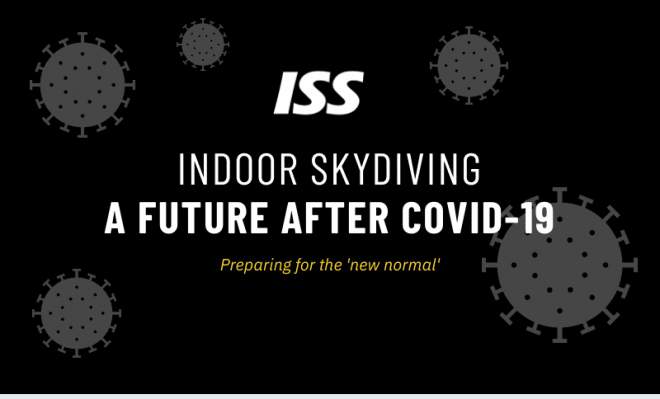News
The Impact of COVID-19 on the Indoor Skydiving Industry

[the_ad_placement id=”article-above-content-mobile-only”]
Let’s face it, in 2020 the world has turned upside down and unless you’re Bill Gates, you didn’t see it coming.
From the positive outlook at the 1st Indoor Skydiving Global Summit in February to the worst global crisis of the 21st century just weeks later.
COVID-19. Coronavirus. Quarantine… Just some of the words that are on everyone’s lips. The global pandemic has obviously had devastating effects that I don’t need to highlight to you here and sadly, the indoor skydiving industry is no exception. Most tunnels around the world have been forced to close temporarily and many new development projects have been hammered by tanking economies and fearful investors.
And it seems as though the end is not in sight just yet. Many health experts say that until we have a vaccine for the deadly coronavirus, outbreaks will continue to occur. Consequently, we should expect to see high amounts of volatility across many industries.
So what are we supposed to do with all this uncertainty?
A couple of years from now we will look back on these unprecedented times as a memory. We’ll say, “I can’t believe that really happened” as well settle back into our normal lives.
But what exactly will the ‘new normal’ look like in the coming weeks, months or years?

Want to use this infographic? Go ahead! Just link back to this article to say thanks.
Indoor Skydiving After COVID-19
While the crisis will impact us all in different ways, we must not forget that this extremely unsettling time is an opportunity for creativity, growth and innovation; a chance to reflect on our priorities and realign our focuses.
Simon Ward, CEO of iFLY reassures us that things WILL go back to normal sooner or later:
“Like every other accepted way of life, things will change, but maybe, just maybe for a short time. Social Distancing and sanitisation today will be at hyper level and will set a number of new standards for future operations. However, if COVID-19 becomes controllable through vaccine or just subsides, then we will be left with human habits such as togetherness, hugging, intimate groups going back to near normal. The challenge is to manage that period which is of unknown duration.”
So how can we prepare for this period of unknown duration? How long will tunnels operators have to ride out the storm and should flyers be concerned about getting back in the tunnel?
When will tunnels reopen?
We all know by now that nothing’s for certain in 2020. Different countries have been impacted by COVID-19 at different times and some worse than others.
While Sweden’s relaxed approach to the crisis means that Bodyflight Sweden still has tunnels operational on the weekends, this isn’t the case for most tunnel operators, who will be lucky if they can get up and running again before the end of the summer.
Ivars Beitans, President of tunnel manufacturer, Aerodium, has told ISS that they expect tunnels around the world to start opening as early as May:
“As East Europe has suffered the least from COVID-19, we are planning to open our wind tunnel business by late May or early June. Our China subsidiary are about to open for the summer around the same time. Our partner in Branson, Missouri is also planning to be open by June.”
Beitans’ optimism looks promising for flyers who are eager to get back in the tunnel, but he also notes that the reality of the situation is not so positive for tunnel operators…
- Less disposable income of potential customers
- Drop of optimism in consumer behaviour
- Fears of infection
- Decrease of tourism-driven customers
These are all reasons why Beitans thinks we should prepare for this summer to be a tough one. It’s down to the tunnel operators to use this knowledge to get prepared for the ‘new normal’.
What can tunnels operators do to prepare?
When tunnels are able to get back to business it’s clear that systems will need to be updated. Tunnel operators must take it upon themselves to implement the necessary safety requirements and follow government recommendations.
Of course, it is imperative to do this to ensure the safety of customers, but it’s equally important to help restore the consumer confidence in the Indoor Skydiving industry as a whole.
Aerodium’s Ivars Beitans confirms:
“I think we will have to re-invent all customer service procedures. Things like disinfection flying gear, social distancing during gearing up, maybe even wearing protective face masks before and during the experience. I believe some safety measures will be in place for a longer time (up to a year or two) until a vaccine is created, so to enable re-opening of our businesses we will have to follow some new rules.”
Anders Eriksson, CEO of Bodyflight Sweden suggests that this ‘downtime’ might be a good opportunity for tunnel operators to work on repairs, improvements and team-building:
“Take care of your staff, take the time to fix the things you can’t during ‘normal times’ if possible and stay positive.”
It’s also worthwhile considering that many governments will be implementing a ‘stage strategy’ to get back to normal life. This means that we will not all of a sudden be running out to the streets to go to shops and restaurants, attending sporting events and booking trips to the Bahamas. It will be a gradual process and one of the initial stages is likely to include restrictions on venue capacity. Spain has already announced a 30% restriction for the initial stage post-quarantine.
Tunnel operators must consider the logistics of meeting these capacity restrictions. As such, it may be worthwhile taking the time to consider new ways to package and promote the indoor skydiving experience. Consider some of the following:
- Private party packages
- One-to-one coaching offers
- Family deals
These are all ways to book out the tunnel for longer periods of time and avoid having overlapping customers sharing the same space.
Here’s some food for thought:
Could a coronavirus swab test upon arrival be a plausible option? It might seem a bit scary or intimidating but given the severity of the current situation, customers might find it reassuring to know that no one is allowed into the tunnel without having been tested for the virus first.
Is Indoor Skydiving safe for customers after COVID-19?
It seems that there is little reason for concern over whether indoor skydiving will be safe for customers in the coming months. As with all industries, business owners will make it their top priority to ensure a hygienic and sterile environment for their customers to be able to enjoy getting back to having some worry-free playtime.
Indoor skydiving tunnels have always had to operate on strict procedures in order to guarantee the safety of their customers and this puts them in as good of a position as any to implement new processes in accordance with government guidelines post-COVID-19.
How will the indoor skydiving industry change over the coming 12-24 months?
So what does the future look like?
iFLY CEO, Simon Ward paints a realistic yet not-so-scary picture:
“Like every industry, Indoor Skydiving will rise to the challenge and introduce new practices to amplify safety precautions and good practices, many of which are already in place in most tunnels around the world. For now, there will be extra vigilance and changes to practices where items need to be touched by many people such as sign in screens, there will be additional cleaning and sterilisation, equipment will be one-time use before thorough cleaning and social distancing will become common whether in the viewing area, classroom or staging area. We are likely to see classes made smaller and less time required at the tunnel to enjoy the experience.
Communication and messaging will be important, customers in all businesses will be looking for reassurance, but beware, it will become so common that people will no longer read it – are you reading everything coming your way right now?”
One question you have to ask yourself is: Could the fear of air contamination last long enough to cause a shift in the market towards open-flow and open-air tunnels?
Aerodium manufactures all three types of tunnels but president, Ivars Beitans is still unsure what the answer is.
“I believe there is absolutely no risk to go flying in open tunnels because we are pushing so much atmospheric air through it. Of course, each operator has to implement all safety measures to disinfect the gear people will be wearing. Regarding the recirculating indoor tunnels I don’t have a clear answer yet. The problem is the same air is recirculating over and over. To avoid catching disease maybe we will advise to use N95 face masks and close helmets.”
In summary
These are turbulent times for many industries as companies stop dead in their tracks and cash dries up. The effects of the crisis will be felt for years to come but a new normal will soon be established.
While uncertainty drives fearful decision making, we must remember that it is our ability to adapt to the new normal that will allow us to reinforce the strength of the Indoor Skydiving industry.
Prepare, communicate and look after one another.
What do you think the future looks like? Think there’s something we’ve missed? Let us know in the comments!
Published: April 29, 2020 | Last Updated: December 2, 2021
Don’t miss an update!
Join our mailing list for the latest indoor skydiving updates delivered directly to your inbox.
"*" indicates required fields

